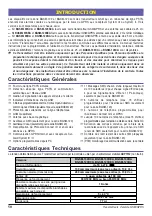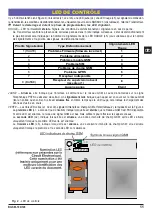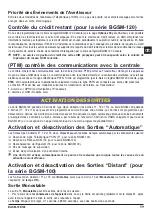
44
GSM/GPRS Alarm Communicators
Main Receiver, Local Port 1 and Alarm Port 1 IP address
Enter the primary receiver IP addresses and port numbers. For Sur-Gard SYSTEM III and SYSTEM II enter the IP address
and the port listed in the
Alarm Port
section.
Backup Receiver, Local Port 2 and Alarm Port 2 IP address
This check box is used to enter the second IP address for the receiver and the port number, with the difference that these
parameters are considered as a backup receiver. The Communicator only recognises this box if the parameters corresponding
to the
Main Receiver
,
Local Port 1
and
Alarm Port 1
address have been entered. Furthermore, the
Enable supervision
and
Supervision time
boxes refer only to the main receiver.
APN1 Username and Password, APN2 Username and Password
Some providers may require a user name and password to validate communication. If needed, enter this information here.
APN2 Username
and
Password
are considered to be backup data.
Telephone numbers to decode
Up to 4 telephone numbers called by the control unit may be entered in these boxes (the number should be composed of at
least 2 digits). When the Communicator recognises a call from one of these numbers, communication via GPRS begins
automatically. Every time a number called does not correspond to one of the numbers entered, the call is transmitted over
a vocal channel. If no telephone numbers are entered, the Communicator will use the GSM or PSTN line.
,
,
,
,
,
ATTENTION: The dialled number appearing in the “Digits to remove” area shows that the call is being sent
on the vocal channel or GPRS, e.g.:
1) if the input telephone number programmed on the “Telephone numbers to decode” fields is 0123, the
numbers input in the digits to be removed area is 2 and the composed number is 0123, the call is being sent
on the vocal channel;
2) if the input telephone number programmed on the “Telephone numbers to decode” fields is 0123, the
number input in the digits to be removed area is 2 while the composed number is 000123, the call is being
sent on the GPRS channel.
DNIS
If required, enter the Dialled Number Identification Service number.
Account code
The account code for communication with SYSTEM III or SYSTEM II receivers must be entered in this box.
Enable Supervision
To enable supervision, select this option. The supervision option is ONLY available to the main receiver. The supervision
messages are not sent when the device is performing a voice call (on GSM).
Supervision time (sec)
Set the Supervision time for the monitored receivers. It is possible to set a Supervision time between a minimum of 5 second
and a maximum of 65535 seconds, with steps of 1 second.
Web Service (BGSM-120 series only)
The
Web Service
is an interface which can be used to access, via the network, the features offered by the BGSM-120
Console software application. The transmitter parameters can be managed remotely using this interface. To use this function,
visit the web address http://www.bentelreachme.com.
Enabled
: To enable the Web Service, click this check box to enter a tick
(this setting is enable by default).
Encryption key
: The encryption key can be set so that the Web service cannot be accessed by unauthorised persons. The
encryption key may include between 1 and 32 hexadecimal characters. The default setting is 0 (encryption key not enabled).
Status
This page will allow you to monitor and control in real-time all the Communicator functions.
,
,
,
,
,
ATTENTION: This page is updated every 5 seconds.
Содержание BGSM-100 Series
Страница 9: ...I I I I I BGSM 100 120 9 Fig 3 Esempio di collegamento per la serie BGSM 100 e BGSM 120...
Страница 32: ...32 GSM GPRS Alarm Communicators Fig 3 BGSM 100 and BGSM 120 wiring diagram...
Страница 54: ...54 Transmetteurs d alarme GSM GPRS Fig 3 Exemple de branchement pour la s rie BGSM 100 et BGSM 120...
















































